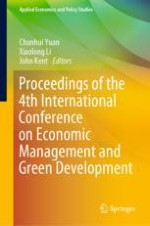2021 | OriginalPaper | Chapter
Ability to Absorb Knowledge and Endogenous Economic Growth: Expansion of Romer Economic Model
Author : Zhiyuan Zhu
Published in: Proceedings of the 4th International Conference on Economic Management and Green Development
Publisher: Springer Singapore
Activate our intelligent search to find suitable subject content or patents.
Select sections of text to find matching patents with Artificial Intelligence. powered by
Select sections of text to find additional relevant content using AI-assisted search. powered by
